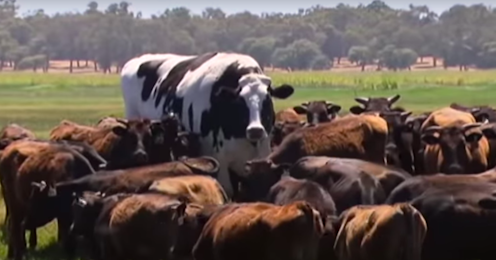Yes, Knickers the steer is really, really big. But he's far short of true genetic freak status
- Written by Sonja Dominik, Research scientist in animal breeding and genetics, CSIRO

The story of Knickers the giant steer has gone viral on social media over the past week. Admittedly, the pictures show him towering over a herd of young Wagyu steers, with Wagyu being one of the smaller cattle breeds, which even enhances his size.
Nevertheless, Knickers is undeniably an impressive beast, standing 194cm tall and weighing a whopping 1.4 tonnes. He is a Holstein-Friesian, which is a large dairy breed. Even Holstein-Friesian cows can grow up to 160cm tall and weigh up to 900kg, and the boys are typically taller and heavier still.
However, Knickers stands literally head and shoulders above the rest, and as an agricultural geneticist I am thrilled that the limelight has been shone in a fun way on our beautiful livestock.
Read more: Watching over livestock: our guardian animals
How much do cattle vary?
The story of Knickers has probably encouraged a lot of people to think about the size of cattle for the first time, and to appreciate how much they can vary.
There is an astonishing amount of variation in size between cattle breeds, from the diminutive Dexter breed, the smallest European breed standing at around 100cm, all the way up to the gargantuan Chianina, the world’s largest cattle breed which features the current all-time record-holder, an Italian ox called Bellino who measures a stunning 202cm. All shapes and sizes of cattle breeds are represented in between these two extemes.
Is there an ideal cattle size?
The question as to why there are such vast differences in size goes back to the time when cattle were first domesticated around 11,000 years ago. One of cattle’s wild ancestors, called Aurochs, were even taller than Knickers, with many bulls standing more than 200cm tall.
Since domestication, cattle have been bred for different purposes, including pulling a plough, or producing milk or meat. These understandably require different body characteristics. The “ideal” size is also influenced by the amount and quality of forage available. Put simply, larger cattle need more food than smaller ones, so if food is scarce, smaller cattle provide a more productive option.
The ideal size of the animals might also be influenced by the availability and size of handling and housing facilities. These days, beef cattle’s size is very strongly influenced by the ideal market size (which saved Knickers, he was too big to go to slaughter).
Is Knickers a freak?
On first observation, some of the most common beef breeds, such as Angus and Hereford, might be described as “all the same size”. Yet there is a surprising amount of variation even within each of these breeds.
Typically, the size distribution within a herd of breed follows a bell-shaped curve, with a few small cattle, a few large cattle, and the majority somewhere in between.
So where does Knickers sit on this curve? The answer is: a long way towards the big end, but not quite into genuine freak territory. Within the Holstein-Friesian breed he is exceptional, but within the extreme end of the existing known range for males.
How did he reach such mammoth proportions? Basically, all the cards fell his way. Males are bigger on average than females, and castrated males (steers) are bigger than entire males (bulls). Castration influences hormones, which delays the completion of bone growth, particularly in the limbs. And on top of all that, Knickers is seven years old – far beyond the age at which cattle are typically taken for slaughter.
Read more: Food for thought: the rise of Australia's mighty Brahman
So unlike most cattle, Knickers has been allowed to grow old – with the emphasis on grow.
So yes, as you may have gathered from browsing literally any part of the Internet this week, Knickers is a big unit – maybe the biggest steer in Australia. But his size is nevertheless very much within the biological parameters of his breed.
Yet while he is not quite a genetic one-off, to me he is still a superstar, because he has triggered a curious conversation on cattle. Next time you go past a paddock of calmly grazing cows, pay attention to differences you observe and marvel at these magnificent animals.
Authors: Sonja Dominik, Research scientist in animal breeding and genetics, CSIRO





